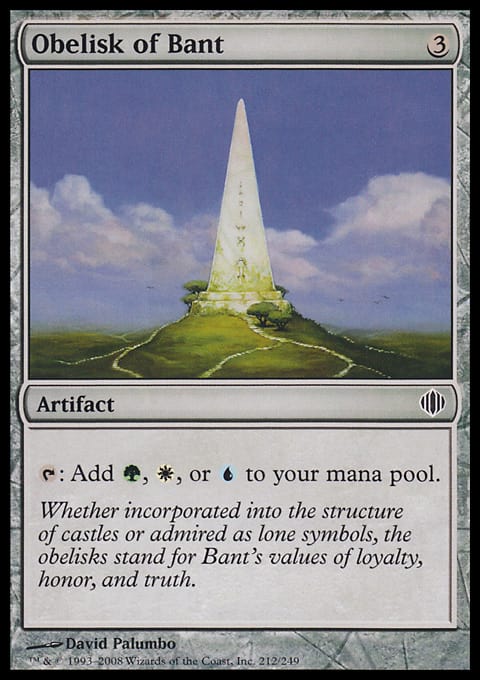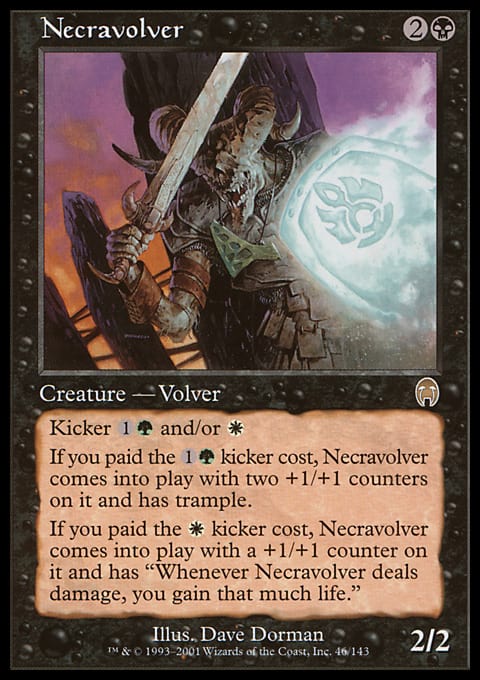Now, take Ravnica block: All ten three-color combinations are viable. Yes, half of them require you to draft off-guild, but there’s a far lower opportunity cost to doing that relative to Shards. For one, you would only have to draft off-guild for a third of the Draft. Second, the presence of hybrid-mana cards further mitigates the cost of having fewer playables in your off-guild pack. Deck diversity is among the reasons I think the original Ravnica block is awesome, and the lack thereof in Shards helps to articulate my disdain for it (the high variance of gameplay due to the insane color requirements was another).
Of course, Return to Ravnica is a different beast than its progenitor, but there’s enough of a family resemblance that I feel I can make some judgments before actually playing with the cards. One of the first things I did when looking at the spoiler was work out which three-color combinations have access to more than one guild. These are:
| Azorius + Izzet | Azorius + Selesnya | Golgari + Selesnya | Izzet + Rakdos | Golgari + Rakdos |
You’ll notice that the guilds and colors are evenly distributed among these five combinations. Keeping them in mind when you’re drafting will help you formulate strategies more efficiently. Another interesting thing to note is that for each color, there is exactly one of the above combinations in which two guilds share that color. This is helpful if you’re solidly in one color (like say if you have a run of good mono-colored cards in the same color) and aren’t sure what guilds to go into. You should always go with what’s open, but in the absence of other information, it’s good to know which two guilds give you the highest number of playables in your color. I don’t expect this to come up all that often—there aren’t all that many mono-colored cards—but if you open something like a Mizzium Mortars, you should value blue and black cards higher than green or white cards. That might be obvious to most people, though it never hurts to think about these things ahead of time.
This isn’t to say that you’re restricted to drafting the above five three-color combinations. It’s perfectly fine to be mono-guild or mono-guild-splashing-a-color. The best deck in triple-Ravnica was U/B mill, and most of the best archetypes were strictly two colors. I have a feeling that the average number of colors in a Return to Ravnica Draft deck will be between two and three, but it’ll probably be closer to three. In any case, I think it will be larger than triple-Ravnica’s average number.
Now, let’s get into actual cards and specifics. I’m not going to do a card-by-card set review or anything, but I’m going to go through each guild and identify what I believe will be the key cards or strategies. I’m going to focus on commons and uncommons because they define the format far more than the rares or mythics. It’s not meant to be exhaustive, either, so don’t write me an angry letter because I didn’t list your favorite card or anything.
Azorius

W/U flyer decks are as old as drafting, so it’s really no surprise that a lot of the Azorius cards lend themselves well to this strategy. The detain mechanic fits perfectly here, allowing you to further press any tempo advantage or let you catch up when behind. Faerie Impostor is awesome since there are a lot of creatures that detain when they enter the battlefield. Being able to rebuy these effects for the low cost of one additional ![]() is insane, especially considering that it comes attached to a 2/1 flyer. Detain also allows Stealer of Secrets to connect more reliably, making it that much better. Once you have multiple Stealers, you pretty much take cards with the word “detain” in the text box over anything.
is insane, especially considering that it comes attached to a 2/1 flyer. Detain also allows Stealer of Secrets to connect more reliably, making it that much better. Once you have multiple Stealers, you pretty much take cards with the word “detain” in the text box over anything.
Golgari
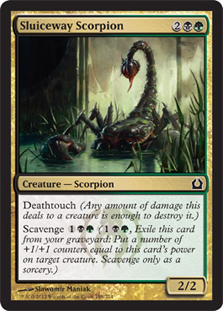
Golgari decks are all about grinding your opponent out. You start out with some reasonably-sized creatures and trade off with your opponent’s men when necessary. Things start becoming exciting when you can start using scavenge to make some scary threats. Once Daggerdrome Imp becomes a Baneslayer Angel, you’ll know why I think he’ll end up being one of the more important creatures in the deck. Grisly Salvage is another key card. I’m a big fan of cards that help you both when you’re short on lands or action. Because of scavenge, you’re often generating more than a card from it. Speaking of which, all the scavenge cards are playable, but I’ve highlighted the ones that are actually decent on their own.
Izzet
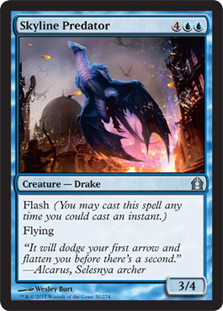
- Blustersquall
- Guttersnipe
- Izzet Staticaster
- Runewing
- Skyline Predator
- Thoughtflare
- Viashino Racketeer
Izzet decks are somewhat harder to define. That might be because of the non-self-reinforcing nature of the overload mechanic. This is just a fancy way of saying that overload cards don’t have much synergy with each other—unlike, say, detain. That just means that Izzet decks are less linear and fall more into the good-stuffs camp. I can also see Izzet cards fulfilling more of a support role with other guilds. Regardless, you do have a pretty good incentive to play with a bunch of spells in your deck, particularly instants. Creatures with flash fit perfectly in this strategy, as it’s far less obvious you’re holding a Skyline Predator when you could just be holding a Thoughtflare. It’s hard to say how fast the format will be, so it’s entirely possible I’m overrating these cards, but I did say these were my first impressions.
Rakdos
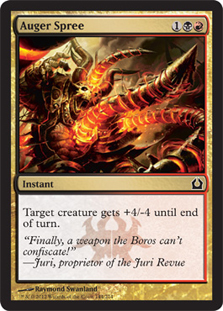
If there’s an all-in strategy in this format, you can bet it will contain some black and red cards. Rakdos decks are only interested in the attacking part of the attack phase, so you really need to win the game quickly. Prioritize cheap, efficient cards over slower, more powerful options. Basically, pretend this is Zendikar. There isn’t a ton of burn, and what little is available is pretty expensive, so you need to lean on your creatures to do the damage. It’s fine to have a couple expensive finishers like an Explosive Impact or a Spawn of Rix Maadi, but you really need to have a decent board presence before you get there; otherwise, you’re not taking full advantage of the unleash mechanic.
Selesnya
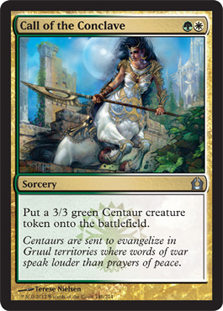
- Call of the Conclave
- Coursers' Accord
- Eyes in the Skies
- Gatecreeper Vine
- Phantom General
- Trostani's Judgment
It doesn’t take a rocket surgeon to figure out that cards that make tokens and cards with the populate ability work well together. In that sense, Selesnya decks are very straightforward to draft. Just don’t fall into the pitfall of playing cards just because they have populate. Cards that both make a token and populate are where you want to be. These decks are hungrier for mana than most, so Gatecreeper Vine is more valuable than in Golgari. Another direction you can take is to just take efficient creatures and every Fencing Ace you see and go balls-deep on pump spells. Common Bond works very well here and has the hilarious side benefit of ruining the day of any opponent who plans on blocking with an unleash creature.
Bonus: Mono-Defender Control
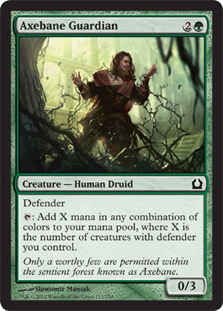
I have no idea if this is even viable, but it’ll be fun to try. This is what Alex Borteh would call a “mongo deck” (if you’re not watching his stream, you need to open a new tab and follow him: www.twitch.tv/bigborts). My feeling is that these cards won’t be any good until we’re drafting the entire block, but the basic game plan is to gum up the board with as many big butts as possible so you can go deep with Doorkeepers. The aforementioned Gatecreeper Vine is a high pick for any green drafter, so you need to take them highly for yourself, but the rest of the cards should be easy to pick up. Black doesn’t add a ton in terms of mill, but its removal spells will help a lot with staying alive.
Wrapping Up
How these five guilds interact both with and against each other has myriad possibilities, and I can’t wait to explore them. Innistrad was a slam dunk for Limited, so I have high hopes for Return to Ravnica. Until next time, choose your guild wisely, and have fun at the prerelease!
Nassim Ketita
arcticninja on Magic Online
www.youtube.com/nketita














